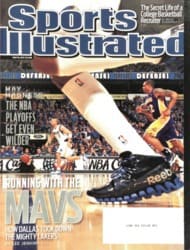
Spellbound By Seve
There's a moment at the 1997 Ryder Cup that I think of now. That year's tournament between the best of Europe and the U.S. was at the Valderrama Golf Club, in Sotogrande, Spain, along the Alboran Sea. The captain of the European team was the most celebrated Spanish golfer of them all, Seve Ballesteros, and he was everywhere. He drove his golf cart fast from hole to hole, and he cheered on his players, coaxed them, challenged them, scolded them. This was Ballesteros in full.
They called him El Matador. His handsome face and flamboyant game demanded the nickname of an action hero. Ballesteros would drive balls into trees, into roughs, into galleries, under cars, into villains' lairs. Then he would summon impossible shots that leaped over tall buildings, bounced over traps, rolled up to greens. He would follow with chip shots softer than the housing market, and if the ball dared not drop, he would stare angrily, as if personally betrayed. Birdies, he felt, were his birthright.
Ballesteros had learned the game by hitting three-iron shots off the beaches near his home in the village of Pedreña. "I could do magical things with that three-iron," he would say. The magic soon circulated to his other clubs. He won the Dutch Open at 19, the British Open at 22. He had just turned 23 when he won his first Masters, making him (until Tiger Woods) the youngest to do so, as well as the first European.
The Masters, more than any other tournament, awakened Seve's sorcery. Augusta National demands imagination and touch, and Ballesteros had those in bulk. He won the Masters again in 1983, and almost won in '85 through '87. It is telling that in the year after each of those wins, he missed the cut. He was an all-or-nothing golfer. He either sawed the woman in half or, yes, it got kind of messy. That was part of what made him so mesmerizing.
He won the British Open three times—there, too, on those bumpy and windy links courses, his ingenuity reigned. Nobody, Nick Faldo says, could escape doom like Seve. Long before television went 3-D, Ballesteros seemed to pop out of the screen. You couldn't watch him play golf and not think, I want to do that.
Escaping doom, though, is the work of young men, and Ballesteros's game did not age well. His wild drives grew wilder. His deft touch dulled. His back throbbed. He four-putted at the Masters once, and when asked how one of the great putters in history could do that, he said plainly, "I miss ... I miss ... I miss ... I make."
Ballesteros was 34 when he last contended at a major championship. He made his last major cut when he was 39. In later years he would show up at the biggest tournaments with the clear understanding that he would not be around for the weekend. Everyone was just happy to see him.
That was the thing about Ballesteros. He made people happy. Golf is a conservative game, often best played cautiously. Woods has never romanced tournaments, he's strangled them with pars on Sunday. With Ballesteros, golf was about making art. He wanted to create something unforgettable. I asked him once about those straightforward pars that have won tournaments for others. "Boring," he said.
He could not be boring. Yes, it was a bit sad to watch him flail away at the end—like watching James Bond confront a bad guy only to get shot in the leg—but then Seve would snap-hook some shot over a parking lot and around a tower and remind us of what he had once been.
By the 1997 Ryder Cup, Ballesteros was through as a great player, but he was mesmerizing as a captain. He drove that souped-up cart like a bootlegger outrunning the county sheriff. He almost ran over spectators. The Ryder Cup had always meant so much to him—he and his friend and protégé José María Olaàbal lost only two of their 15 matches together—and this was the climax: the first Ryder Cup in his home country.
"There must be two of him," a BBC announcer said at one point. Ballesteros would read a putt for this player, race ahead to tell another how to hit his approach, ride two holes back to hug someone. "Seve knows what he's doing," Europe's Colin Montgomerie said amid the chaos. "He's the only one who knows what he's doing."
John Updike once wrote that immortality is nontransferrable, but Ballesteros sure tried. The U.S. was favored, but nobody had ever run a golf team like this. The Europeans built a big lead and held on for the win. An exhausted Ballesteros broke down and cried. He called it his greatest victory.
The moment I think about was a small one from a practice round that week. Ballesteros pulled his cart next to Ian Woosnam, whose ball was buried in the woods. There seemed no escape. Seve surveyed the situation, and suddenly he saw the way out.
"Do you see that crack up there on top of the tree?" Ballesteros asked, excitement in his voice.
Woosnam looked up. "No," he said.
"Up there," Seve said more insistently. "Between the branches? See?"
Woosnam looked harder.
"No," he said again, and chipped out to safety.
Seve Ballesteros died last Saturday from a brain tumor. He was 54 years old. All his too-short life, he did not fear trouble. Why would he? Ballesteros could see the openings others could not see. He could always find his way home.
The Poscast
Listen to Joe Posnanski's podcast (this week's guest is TNT basketball announcer Kevin Harlan) at si.com/poscast
With Ballesteros, golf was about making art. He wanted to create something unforgettable. Basic pars that won for others were "boring."
PHOTO
DARREN CARROLL

